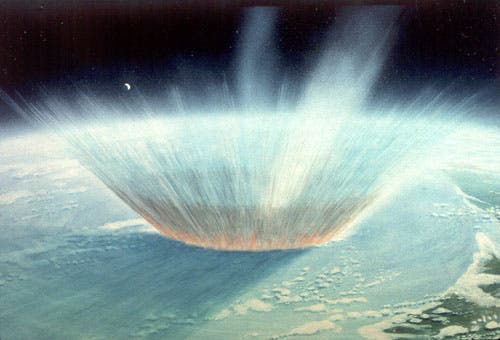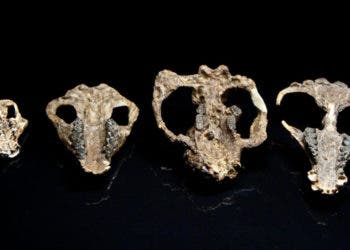
Around 66 million years ago a 6-mile wide asteroid hit the planet near the town of Chicxulub, Mexico. The impact resulted in a huge explosion and created a 100-mile crater. Debris was flung in the air at a height twice that of Mount Everest, and a plume of dust and ash engulfed the whole planet, shielding the sun and causing nuclear winter-like effects. Countless species were eradicated, among them all the dinosaurs (except birds).
Among scientists, there’s a debate as to how all of this mayhem played out. There are two trains of thought. The first suggests that once the asteroid hit Earth, the immediate subsurface melted, moving material from side to side. The material then moves towards the center and becomes uplifted creating the familiar ‘peak rings’ we can see to this day at the Chicxulub crater. The other hypothesis is far more dramatic, proposing that fluid-like material was propelled from deep beneath the Earth’s crust.
Sean Gulick, a geophysicist at the University of Texas, Austin, and colleagues, traveled to Chicxulub and drilled the crater. Immediately after they recovered the first cores, there was no doubt in the researchers’ minds that the impact physics were described by ‘hypothesis #2’.
The Cretacious Period, the geological timeframe during the asteroid impact, is characterized by abundant limestone. However, the cores were made of pink granite which is typically found deeper beneath the Earth.
“And it was just plain as day,” he says, “and everybody staring at it went, ‘Wow, there’s the answer. It’s from deep,'” said Gulick.
Here’s how Gulick describes the mass extinction triggering event, liking it to a rock hitting a water pond.
“It makes a hole initially as the rock penetrates into the pond. And the sides will sort of collapse inward toward the hole while the center kind of rebounds up like a big water droplet rising up.”
“If you picture all of this happening in a slightly slower-moving fluid than water would be, you can envision that the center that rebounds upwards and splashes upwards would kind of collapse outwards. So just as the sides are falling in, this rebounding center is sort of collapsing outwards to create … this ring of mountains, made from material that ultimately came from fairly deep.”
And it all took no more than 10 minutes.
That’s not to say that all the physics behind the impact are solved. Many questions remain unanswered. For instance, although the rocks behaved like a fluid, they remained solid. The huge energy from the impact altered the rocks’ cohesion causing them to move like a slow-moving fluid, though.
Next, the researchers plan to analyze in greater detail the pink granite which came from 6 miles beneath the surface. They think it might provide hints as to how life rebounded after the unfortunate event.
Findings appeared in Science.






